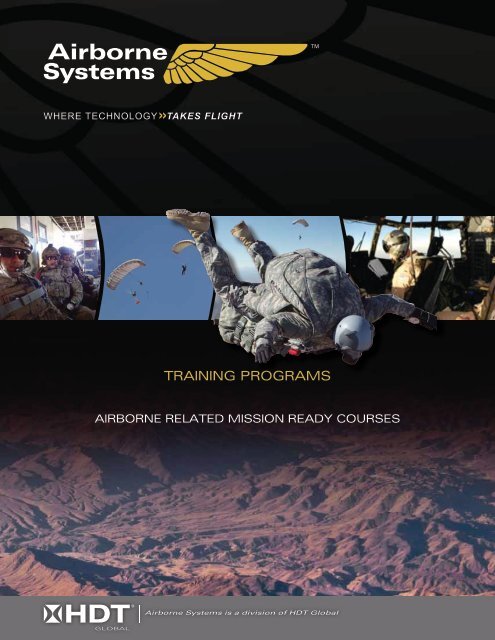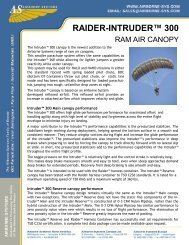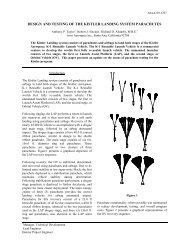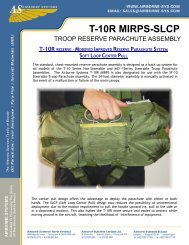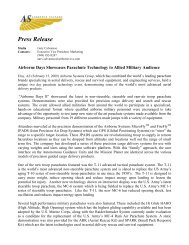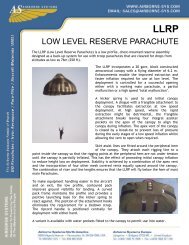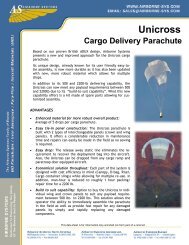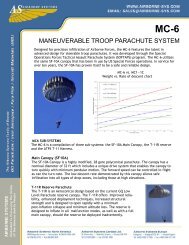Training Programs - Airborne Systems
Training Programs - Airborne Systems
Training Programs - Airborne Systems
Create successful ePaper yourself
Turn your PDF publications into a flip-book with our unique Google optimized e-Paper software.
<strong>Training</strong> <strong>Programs</strong><br />
airborne relaTed mission ready Courses
QualiTy and serviCe CommiTmenT<br />
We are committed<br />
to superior quality,<br />
high-performance and<br />
technology-leading<br />
innovation.<br />
With more than 90 years of experience in<br />
providing parachute equipment to military<br />
forces around the world, <strong>Airborne</strong><br />
<strong>Systems</strong> understands better than anyone<br />
else the need for product and personnel<br />
training to support mission readiness and<br />
enhance operational capability.<br />
2 3<br />
Every day, we create value for our customers worldwide as<br />
we change and add capabilities throughout the organization<br />
from systems engineering and creative design, to<br />
project management and manufacturing, using the latest<br />
technological tools. We are especially proud of our creative<br />
design team and our simulation and analytical capabilities.<br />
Through teamwork, innovation, and continuous<br />
improvement, we deliver advantage, benefit, value, and<br />
satisfaction. We are committed to high-performance,<br />
superior quality and technology leading innovation as our<br />
contribution to the success of our customers’ missions.<br />
• Developer of most parachutes and oxygen<br />
system fielded with the US military.<br />
• World class instructor cadre specializing in<br />
teaching Military Free Fall and airdrop operations<br />
• All training courses can be modified as<br />
required to meet customer requirements.<br />
• Unmatched aircraft support through<br />
Skydive Arizona<br />
• US Air Force-surveyed drop zones for<br />
personnel and cargo<br />
• 14 ft diameter vertical wind tunnel capable of<br />
supporting students flying combat equipment<br />
• Airspace availability to 25,000 ft Above<br />
Mean Sea Level<br />
• Local climate supports 340 flying days per year<br />
Our history and legacy began in 1919, when Leslie Irvin, the founder of<br />
the Irvin Air Chute Company, made the first ever freefall parachute jump<br />
with a parachute that was manually releasable in freefall.
THe leader in miliTary Program ProCuremenT<br />
airborne systems<br />
is the developer of<br />
virtually all parachutes<br />
and parachutist<br />
oxygen systems<br />
that are now being<br />
fielded to us and<br />
international Forces.<br />
<strong>Airborne</strong> <strong>Systems</strong> is the developer of virtually all<br />
parachutes and parachutist oxygen systems that are now<br />
being fielded to US and International Forces. Recent<br />
product releases include the T-11, MC-6, MicroFly,<br />
GPADS 2K FireFly, GPADS 10K DragonFly, ARAPS<br />
Intruder ® (RA-1), and SOLR. All this equipment allows<br />
a unit to increase its force projection capability while at<br />
the same time increasing the safety of unit personnel.<br />
However, these advantages are only realized when the<br />
equipment is used properly.<br />
As the developer of the latest generation of equipment,<br />
<strong>Airborne</strong> <strong>Systems</strong> is uniquely positioned to train users<br />
in the proper use of this<br />
equipment. Effective<br />
training will bridge the gap<br />
from an equipment purchase<br />
to mission capability.<br />
<strong>Training</strong> on individual skills or<br />
tactical unit training can be<br />
conducted at the <strong>Airborne</strong><br />
<strong>Systems</strong> Tactical <strong>Training</strong><br />
Facility in Eloy, Arizona or<br />
at a customer location. The <strong>Airborne</strong> <strong>Systems</strong> Tactical<br />
<strong>Training</strong> Facility, located in Eloy, Arizona, is extremely<br />
well suited for the conduct of parachute training. <strong>Training</strong><br />
resources include two climate controlled buildings, access<br />
to numerous ramp and side door exit aircraft, a vertical<br />
wind tunnel, and US Air Force approved drop zones for<br />
personnel and cargo drops. <strong>Training</strong> is enhanced with<br />
airspace clearances to 24,500 ft, approvals to use guided<br />
airdrop systems, and weather patterns that support an<br />
average of 340 flying days per year. Maximizing the<br />
benefits of these training resources is a world class<br />
instructor cadre specializing in teaching Military Free Fall<br />
and airdrop operations.<br />
<strong>Training</strong> is divided into two categories: individual skill<br />
training and tactical training. Individual skill training can<br />
be provided as part of equipment purchases, to qualify<br />
personnel newly assigned to a unit, or as part of recurring<br />
proficiency training. Tactical training courses are intended<br />
to qualify operational detachments in the conduct of<br />
specific missions. All training courses can be modified as<br />
required to meet customer requirements.<br />
airborne sysTems <strong>Training</strong> <strong>Programs</strong> 3
individual ParaCHuTe sKills<br />
4 5<br />
individual skill training courses are<br />
focused on qualifying individuals to<br />
perform specific tasks.<br />
Individual skill training is typically conducted as part of<br />
an equipment purchase and is commonly referred to as<br />
New Equipment <strong>Training</strong> (NET). A typical NET will include<br />
rigger training (packing and maintenance) and operator<br />
training (jumper skills/jump master duties). In addition<br />
to being part of New Equipment <strong>Training</strong>, Individual skill<br />
courses are also available to Individuals joining a unit, or<br />
these courses may be scheduled as part of a regular skill<br />
refresher program.<br />
T-11 Course<br />
The T-11 course qualifies rigger students to pack the<br />
T-11 main and T-11R reserve parachutes. Instruction<br />
on inspection, assembly, and maintenance of the<br />
T-11 system are also included. Jumpmaster students<br />
are taught Jumpmaster Personnel Inspection (JMPI)<br />
and aircraft procedures. Depending on customer<br />
requirements, the course can also include a jump<br />
program for both riggers and jumpmasters.<br />
MC-6 Course<br />
The MC-6 course is similar to the T-11 New Equipment<br />
<strong>Training</strong> Course but with a focus on the MC-6 system<br />
(SF-10 main canopy and T-11R reserve).<br />
RA-1 (Intruder ®) Course<br />
The RA-1 course qualifies riggers to pack the Intruder<br />
Main and Intruder Reserve canopies. Rigger students are<br />
also qualified on inspection, assembly, and maintenance<br />
of the RA-1 system. Instruction on converting the system<br />
between static line and free fall configuration is also<br />
provided. Jumpmaster students are taught Jumpmaster<br />
Personnel Inspection (JMPI), how to calculate the<br />
Computed Air Release Point (CARP), actions in the<br />
aircraft, and are given hands on instruction on the flying<br />
of the Intruder canopy.<br />
Hi-Glide Course<br />
The Hi Glide Course is similar to the RA-1 New<br />
Equipment <strong>Training</strong> course but with a focus on the<br />
Hi Glide system. Because the Hi Glide is not static<br />
line capable, all instruction is provided on free fall<br />
configuration only.
all training can be<br />
provided either at the<br />
unit’s location or at our<br />
<strong>Training</strong> Facility in eloy, aZ<br />
PHAOS/OXCON/SOLR Course<br />
<strong>Airborne</strong> <strong>Systems</strong> provides two New Equipment<br />
<strong>Training</strong> courses for the Parachutist High Altitude<br />
Oxygen System (PHAOS), Oxygen Console (OXCON),<br />
and Special Operations Long Range (SOLR).<br />
oxygen maintenance<br />
The Oxygen Maintenance Course certifies users to<br />
calibrate, rebuild, and maintain parachutist oxygen<br />
systems manufactured by <strong>Airborne</strong> <strong>Systems</strong>.<br />
The Oxygen Maintenance Course is a classroom<br />
only course and does not require parachute jumps.<br />
oxygen operator<br />
The Oxygen Operator<br />
Course certifies users in<br />
the safe operation of<br />
parachutist oxygen<br />
equipment. Jumps to<br />
24,500 ft can be<br />
conducted as part of the<br />
Oxygen Operator Course.<br />
GPADS Course<br />
The GPADS (Guided Precision Aerial Delivery System)<br />
Course qualifies students to assemble, inspect, pack,<br />
rig, program, and maintain any of the GPADS platforms<br />
manufactured by <strong>Airborne</strong> <strong>Systems</strong>.<br />
As part of the GPADS Operator Course, students are<br />
taught how to plan missions and conduct GPADS drops<br />
(live drops are typically conducted as part of this course).<br />
jTrax Mission Planner Course<br />
The jTrax Mission Planner course qualifies users to<br />
operate the jTrax Mission Planner in support of all<br />
phases of precision airborne and aerial delivery missions.<br />
Students are taught how to use jTrax for<br />
planning, simulation/rehearsal, programming<br />
(for GPADS), and execution of various types of<br />
missions. Included in the training is instruction<br />
on how to calculate range safety fans (safety<br />
footprints) and how to manipulate mission<br />
parameters to support real world constraints.<br />
airborne sysTems <strong>Training</strong> <strong>Programs</strong> 5
TaCTiCal and advanCed <strong>Training</strong><br />
in coordination with customer<br />
requirements, airborne systems<br />
is also able to support full mission<br />
profiles which allow an operational<br />
unit to conduct an infiltration and then<br />
execute a ground mission.<br />
Combo Drop Course<br />
The Combo Drop Course trains members of a Military<br />
Free Fall team to conduct a mission alongside a GPADS<br />
platform. Prerequisites for the Combo Drop Course include<br />
GPADS New Equipment <strong>Training</strong> and a demonstrated<br />
capability with a ram air personnel parachute system.<br />
The Combo Drop Course can be conducted as a second<br />
phase of a New Equipment <strong>Training</strong> program, as part of<br />
pre-deployment training, or as a stand-alone training event<br />
to develop a new capability. The Combo Drop Course<br />
typically lasts five days and consists of an intensive jump<br />
schedule and mission planning exercises. Successful<br />
completion of the Combo Drop Course certifies an<br />
operational detachment to follow behind a GPADS<br />
platform during an infiltration mission.<br />
6 7<br />
Night Vision Goggle Course<br />
The Night Vision Goggle Course allows an existing<br />
Military Free Fall unit to conduct High Altitude Low<br />
Opening (HALO) and High Altitude High Opening (HAHO)<br />
missions during hours of limited visibility. Instruction is<br />
provided for planning considerations, tactics, techniques,<br />
and procedures. Stepladder progression is provided,<br />
beginning with vertical wind tunnel training followed by<br />
daylight jumps, and culminating in night team jumps. As<br />
a prerequisite to this course, students must be a graduate<br />
of a relevant individual skills course or certified and current<br />
Military Free Fall jumpers.<br />
HAHO/HALO Requalification<br />
The Requalification Course provides refresher training<br />
to Military Free Fall units. <strong>Training</strong> begins with ground<br />
school and wind tunnel exercises and rapidly progresses to<br />
individual jumps and team jumps using Free Fall and Static<br />
Line deployment methods. Further progression includes<br />
jumps with combat equipment and parachutist oxygen.<br />
Typical Requalification Courses last two weeks. Upon<br />
completion, a Military Free Fall unit is fully qualified to<br />
complete a HAHO or HALO infiltration mission.
HigH alTiTude <strong>Training</strong><br />
The extreme conditions present at high<br />
altitudes require proficiency in technical<br />
skills to ensure individual safety and<br />
proper execution of test plans.<br />
High-Altitude Testing Course<br />
The High-Altitude Testing course is intended to certify<br />
experienced parachute technicians to safely conduct<br />
parachute trials at altitudes above 17,500 ft (5.300 m)<br />
Above Mean Sea Level (ASML).<br />
Chamber <strong>Training</strong><br />
The course begins with training in a high-altitude chamber<br />
to ensure physiological suitability for each student to<br />
work at high altitude. Included in the chamber training is<br />
the recognition of the signs and symptoms of hypoxia<br />
and the medical protocols for high altitude injuries. Upon<br />
successful completion of the chamber testing, students<br />
then progress to training on the use and fitting of personal<br />
oxygen systems.<br />
Classroom <strong>Training</strong><br />
The course continues with classroom lectures on the<br />
effects of extreme altitude on parachutes, aircraft, and<br />
personnel. Parachute theory and design concepts are<br />
introduced to enhance understanding of parachute<br />
construction and performance. Additional instruction is<br />
provided on high altitude considerations for parachute<br />
testing. Guidance is provided for the rigging of test<br />
equipment, test collection methods, equipment used to<br />
collect data, and the development of test plans to ensure<br />
complete testing of parachute equipment.<br />
Familiarization<br />
Upon the conclusion of the ground training, students<br />
begin to make familiarization jumps at increasing altitudes<br />
to 24,500 ft (7.500 m) AMSL. As students become more<br />
confident with operating at high altitudes, they will begin to<br />
conduct experiments under instructor supervision. These<br />
experiments include the use of riser load test equipment,<br />
rigging and dropping articulated mannequins, and the<br />
creation of test plans. Data gathered during the course will<br />
be included in a test report generated by the students.<br />
Certification<br />
Upon the completion of the course, graduates will be<br />
certified to conduct parachute testing at high altitude.<br />
They will also have a full understanding of the effects of<br />
high altitude on personnel and equipment. Graduates will<br />
also be familiar with test collection equipment and will<br />
have the ability to create a comprehensive test plan for<br />
high altitude certification of parachute equipment.<br />
airborne sysTems <strong>Training</strong> <strong>Programs</strong> 7
<strong>Airborne</strong> <strong>Systems</strong> <strong>Training</strong> Facility<br />
4790 N Lear Drive, Eloy, AZ 85131<br />
Tel: 856.571.4717<br />
<strong>Airborne</strong> <strong>Systems</strong> North America Headquarters<br />
5800 Magnolia Avenue, Pennsauken, NJ 08109-1399, USA<br />
Tel: 856 663 1275, Fax: 856 663 3028<br />
www.airborne-sys.com


